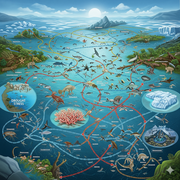Balance is good for ecosystems. It is important for the natural order that all living things work together. These connections have been previously presented by food chains and food webs. However, by 2025, due to new research, the realities of climate change, and global environmental issues, the thinking processes of these significant systems have evolved.
Reviewing Food Webs and Food Chains
What’s the difference between the two? Read on.
The Food Chain
 The flow of energy from producers (plants) to herbivores to hunters can be shown in a simple, straight line.
The flow of energy from producers (plants) to herbivores to hunters can be shown in a simple, straight line.
The Food Web
This is a much more realistic network that shows how species depend on different energy sources and connect to each other. Scientists now know that food webs change over time.
Climate Change and their Effect on Food Web
Food webs around the world have changed because of the following reasons:
- rising temperatures: the melting down of ice at the Arctic sea removes the algae that fish feeds on
- weather uncertainties: the connection between herbivores and pollinators has been damaged by droughts
- changing habitats: fish look for another location on the ocean when their place becomes warm which makes predators die
Ecosystems 2025: Its Resilience
The way an environment adopts from natural circumstances such as storms, fires, or loss of species is known as resilience. However, protecting the habitats is far more important due to the more complicated and diverse resiliency of the food webs.
End Notes
Food webs and food chains are plans for surviving and thriving into the warming up ecosystem. Preserving the environment, safeguarding endangered species, and establishing a process of recovery are ways that we can contribute to our environment. Through these, our nature is able to cope up with the challenges this 2025 and even beyond.



